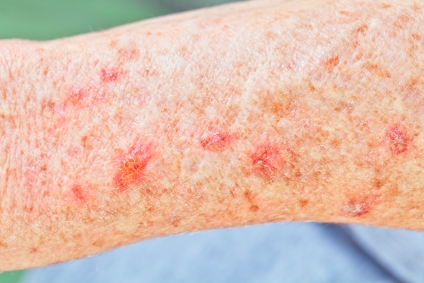Skin Cancer Symptoms
Some forms of skin cancer affect more than one million Americans every year. The most common of all cancers is skin cancer, and it develops when normal skin cells uncontrollably transform, grow and multiply into abnormal lesions or tumors.
Tumors are only considered cancerous if they are diagnosed as being malignant. Malignancy means atypical cells crowd and infiltrate nearby normal tissues as a result of their uncontrolled growth. Cancerous skin tumors can travel to distant organs by way of the lymphatic system or bloodstream. Invasion and spread to other areas and organs of the body is referred to as metastasis. Cancerous cells encroach on surrounding tissue cells by invasion of their space, taking critical nutrients and oxygen needed for survival and function.
Three Kinds of Skin Cancers
The three main kinds of skin cancers are called basal cell carcinoma, squamous cell carcinoma and malignant melanoma. BCCs or SCCs make up the vast majority of skin cancers cases. While they are malignant, the chances of either type spreading to other areas of the body are slim. However, they can become disfiguring if allowed to continue without proper treatment. A small number of skin cancers progress to melanoma, an aggressive form of skin cancer often metastasizing to other body parts. It may prove to be fatal if not detected early.
Signs and Symptoms of Basal Cell Carcinoma
Making up greater than ninety percent of skin cancers among Americans, basal cell carcinoma is the most prevalent type. Basal cell carcinoma lesions generally have the appearance of smooth, pearly, raised bumps on sun exposed skin areas like the neck, head and/or shoulders. Within the tumor itself, small blood vessels may be seen. Quite often a central crater which is crusty and bleeding forms. In many cases, a basal cell lesion will be confused with a sore that refuses to heal properly.
Signs and Symptoms of Squamous Cell Carcinoma
Squamous cell carcinoma is a very common type of skin cancer, and it is second only to basal cell carcinoma. Typically, a SCC will appear as a red, scaly, thickened lesion with well-defined borders that appears on sun exposed areas of the skin. As with basal cell tumors, SCCs can bleed and eventually ulcerate.
SCC lesions can occasionally occur in areas like the genitals and mucous membranes. The most common spots for them to develop are in areas that are overexposed to the harmful UV rays of the sun. These include the rims of the ears, bald spots on the scalp, lower lip, face, neck, arms, hands and legs. If this type of cancerous growth is left without proper treatment, it can eventually progress into a large sized mass.
Signs and Symptoms of Malignant Melanoma
While this type is not as common as those cancers mentioned above, it is responsible for eighty percent of deaths related to skin cancers. The vast majority of melanomas are brown to black colored lesions. Warning signs for melanoma include changes in shape, color, size or even a change in elevation of a mole. New moles that develop during the adult years, or painful, itching, ulcerating and/or bleeding of an old mole, all need to be examined by your doctor or dermatologist.
ABCD Guide
The ABCD guide is an easy, useful tool for detection of a melanoma lesion:
- Asymmetry: Two sides of a lesion are not the same.
- Border: Margins may be irregular or notched looking.
- Color: Lesions are typically a combination of black, brown, tan, red, blue or white colors.
- Diameter: Greater than 6 mm. across. However any change in size should be considered significant.
Those individuals who have a fair complexion, and/or excessive exposure to the sun, should routinely (i.e. monthly) examine their whole body from head to toe for the appearance of any suspicious looking moles or lesions. Have your dermatologist check out any moles or spots that may be worrisome to you. Healthcare professionals are the best judges of possible skin cancers.
Final Thoughts
The most recent studies indicate that the frequency of skin cancer cases in the U.S. is increasing at an ever alarming rate. Thankfully, growing awareness on behalf of Americans and their health care providers is resulting in much earlier diagnoses. This leads to a much better outcome than what was seen in the past.

